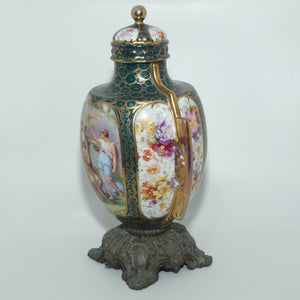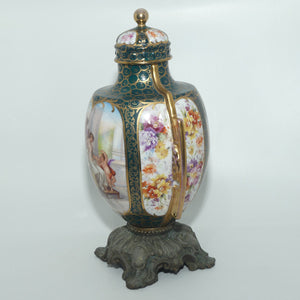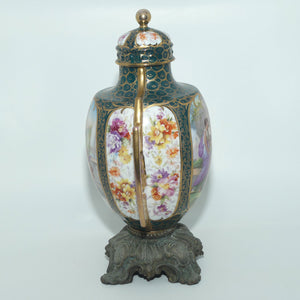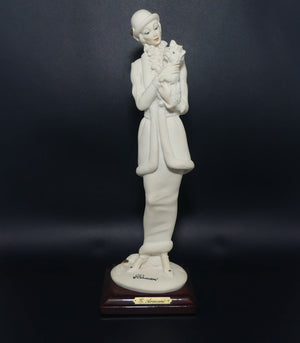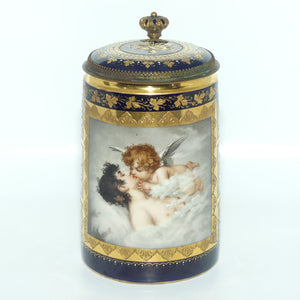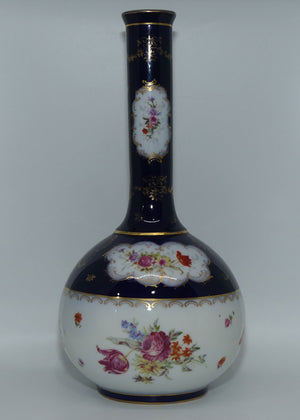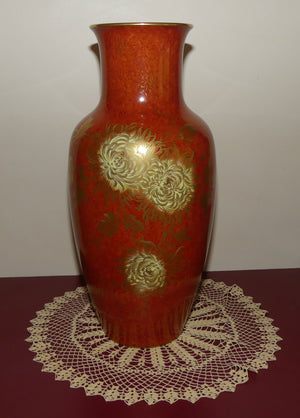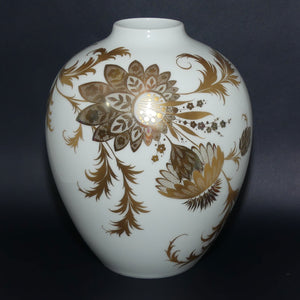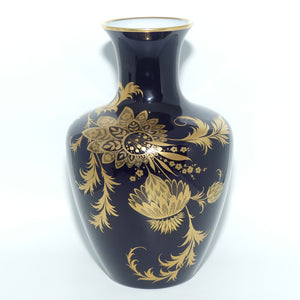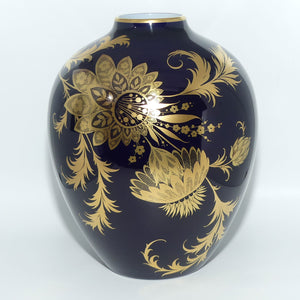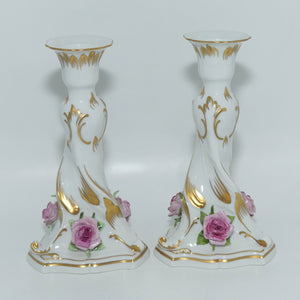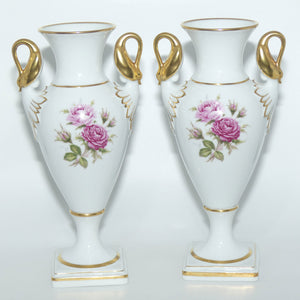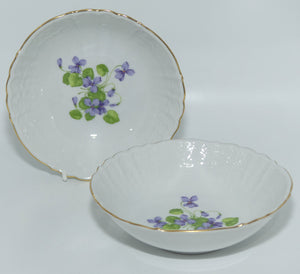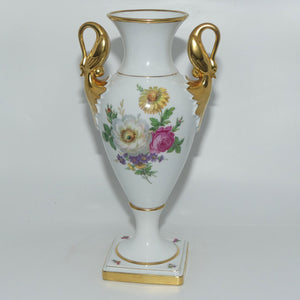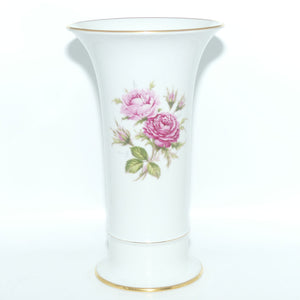{"id":8112714055908,"title":"19th Century Porcelain Lidded Urn with Neoclassical scenes on Spelter base","handle":"19th-century-porcelain-lidded-urn-with-angelica-kauffman-maiden-scenes-on-spelter-base","description":"\u003cp\u003e19th Century Porcelain Lidded Urn with Neoclassical Scenes on Spelter base\u003cbr\u003eThe scenes are transfer decorated from work by Angelica Kauffmann\u003cbr\u003e\u003cbr\u003ec.1880\u003cbr\u003e\u003cbr\u003eThe spelter base is fixed to the urn via a treaded bolt which is concealed under the base\u003cbr\u003e\u003cbr\u003eApprox 32cms (12 1\/2\") tall to top of lid\u003cbr\u003e\u003cbr\u003eIn excellent condition\u003cbr\u003eGUARANTEED free from damage and repair\u003c\/p\u003e\n\u003cp\u003e\u003cstrong\u003eAbout Angelica Kauffmann\u003c\/strong\u003e\u003cbr\u003eMaria Anna Angelika Kauffmann [30 October 1741 – 5 November 1807], usually known in English as Angelica Kauffman, was a Swiss Neoclassical painter who had a successful career in London and Rome. Remembered primarily as a history painter, Kauffmann was a skilled portraitist, landscape and decoration painter. She was, along with Mary Moser, one of two female painters among the founding members of the Royal Academy in London in 1768.\u003cbr\u003e\u003cbr\u003eWhile Kauffman produced portraits, and self-portraits, she identified herself primarily as a history painter, an unusual designation for a woman artist in the 18th century. History painting was considered the most elite and lucrative category in academic painting during this time period and, under the direction of Sir Joshua Reynolds, the Royal Academy made a strong effort to promote it to a native audience more interested in commissioning and buying portraits and landscapes. Despite Kauffman's popularity in British society and her success there as an artist, she was disappointed by the relative apathy of the British towards history painting. Ultimately, she left Britain for Rome, where history painting was better established, held in higher esteem and patronized.\u003cbr data-mce-fragment=\"1\"\u003e\u003cbr data-mce-fragment=\"1\"\u003e\u003cbr data-mce-fragment=\"1\"\u003e\u003cbr\u003e\u003c\/p\u003e","published_at":"2023-12-30T06:00:01+10:00","created_at":"2023-12-24T08:52:47+10:00","vendor":"European","type":"Urn","tags":["Antique","European"],"price":37500,"price_min":37500,"price_max":37500,"available":true,"price_varies":false,"compare_at_price":null,"compare_at_price_min":0,"compare_at_price_max":0,"compare_at_price_varies":false,"variants":[{"id":44429600850148,"title":"Default Title","option1":"Default Title","option2":null,"option3":null,"sku":"232402130C","requires_shipping":true,"taxable":true,"featured_image":null,"available":true,"name":"19th Century Porcelain Lidded Urn with Neoclassical scenes on Spelter base","public_title":null,"options":["Default Title"],"price":37500,"weight":2600,"compare_at_price":null,"inventory_management":"shopify","barcode":"","requires_selling_plan":false,"selling_plan_allocations":[]}],"images":["\/\/www.roundaboutantiques.com.au\/cdn\/shop\/files\/kaufmann_1a.jpg?v=1703884739","\/\/www.roundaboutantiques.com.au\/cdn\/shop\/files\/kaufmann_1b.jpg?v=1703884738","\/\/www.roundaboutantiques.com.au\/cdn\/shop\/files\/kaufmann_1c.jpg?v=1703884739","\/\/www.roundaboutantiques.com.au\/cdn\/shop\/files\/kaufmann_1d.jpg?v=1703884739","\/\/www.roundaboutantiques.com.au\/cdn\/shop\/files\/kaufmann_1e.jpg?v=1703884738","\/\/www.roundaboutantiques.com.au\/cdn\/shop\/files\/kaufmann_1f.jpg?v=1703884740","\/\/www.roundaboutantiques.com.au\/cdn\/shop\/files\/kaufmann_1g.jpg?v=1703884739","\/\/www.roundaboutantiques.com.au\/cdn\/shop\/files\/kaufmann_1h.jpg?v=1703884738"],"featured_image":"\/\/www.roundaboutantiques.com.au\/cdn\/shop\/files\/kaufmann_1a.jpg?v=1703884739","options":["Title"],"media":[{"alt":"19th Century Porcelain Lidded Urn with Neoclassical scenes on Spelter base","id":56310006939876,"position":1,"preview_image":{"aspect_ratio":1.0,"height":1250,"width":1250,"src":"\/\/www.roundaboutantiques.com.au\/cdn\/shop\/files\/kaufmann_1a.jpg?v=1703884739"},"aspect_ratio":1.0,"height":1250,"media_type":"image","src":"\/\/www.roundaboutantiques.com.au\/cdn\/shop\/files\/kaufmann_1a.jpg?v=1703884739","width":1250},{"alt":"19th Century Porcelain Lidded Urn with Neoclassical scenes on Spelter base","id":56310006972644,"position":2,"preview_image":{"aspect_ratio":1.0,"height":1250,"width":1250,"src":"\/\/www.roundaboutantiques.com.au\/cdn\/shop\/files\/kaufmann_1b.jpg?v=1703884738"},"aspect_ratio":1.0,"height":1250,"media_type":"image","src":"\/\/www.roundaboutantiques.com.au\/cdn\/shop\/files\/kaufmann_1b.jpg?v=1703884738","width":1250},{"alt":"19th Century Porcelain Lidded Urn with Neoclassical scenes on Spelter base","id":56310007005412,"position":3,"preview_image":{"aspect_ratio":1.0,"height":1250,"width":1250,"src":"\/\/www.roundaboutantiques.com.au\/cdn\/shop\/files\/kaufmann_1c.jpg?v=1703884739"},"aspect_ratio":1.0,"height":1250,"media_type":"image","src":"\/\/www.roundaboutantiques.com.au\/cdn\/shop\/files\/kaufmann_1c.jpg?v=1703884739","width":1250},{"alt":"19th Century Porcelain Lidded Urn with Neoclassical scenes on Spelter base","id":56310007038180,"position":4,"preview_image":{"aspect_ratio":1.0,"height":1250,"width":1250,"src":"\/\/www.roundaboutantiques.com.au\/cdn\/shop\/files\/kaufmann_1d.jpg?v=1703884739"},"aspect_ratio":1.0,"height":1250,"media_type":"image","src":"\/\/www.roundaboutantiques.com.au\/cdn\/shop\/files\/kaufmann_1d.jpg?v=1703884739","width":1250},{"alt":"19th Century Porcelain Lidded Urn with Neoclassical scenes on Spelter base","id":56310007070948,"position":5,"preview_image":{"aspect_ratio":1.0,"height":1250,"width":1250,"src":"\/\/www.roundaboutantiques.com.au\/cdn\/shop\/files\/kaufmann_1e.jpg?v=1703884738"},"aspect_ratio":1.0,"height":1250,"media_type":"image","src":"\/\/www.roundaboutantiques.com.au\/cdn\/shop\/files\/kaufmann_1e.jpg?v=1703884738","width":1250},{"alt":"19th Century Porcelain Lidded Urn with Neoclassical scenes on Spelter base","id":56310007103716,"position":6,"preview_image":{"aspect_ratio":1.0,"height":1250,"width":1250,"src":"\/\/www.roundaboutantiques.com.au\/cdn\/shop\/files\/kaufmann_1f.jpg?v=1703884740"},"aspect_ratio":1.0,"height":1250,"media_type":"image","src":"\/\/www.roundaboutantiques.com.au\/cdn\/shop\/files\/kaufmann_1f.jpg?v=1703884740","width":1250},{"alt":"19th Century Porcelain Lidded Urn with Neoclassical scenes on Spelter base","id":56310007136484,"position":7,"preview_image":{"aspect_ratio":1.0,"height":1250,"width":1250,"src":"\/\/www.roundaboutantiques.com.au\/cdn\/shop\/files\/kaufmann_1g.jpg?v=1703884739"},"aspect_ratio":1.0,"height":1250,"media_type":"image","src":"\/\/www.roundaboutantiques.com.au\/cdn\/shop\/files\/kaufmann_1g.jpg?v=1703884739","width":1250},{"alt":"19th Century Porcelain Lidded Urn with Neoclassical scenes on Spelter base","id":56310007169252,"position":8,"preview_image":{"aspect_ratio":1.0,"height":1250,"width":1250,"src":"\/\/www.roundaboutantiques.com.au\/cdn\/shop\/files\/kaufmann_1h.jpg?v=1703884738"},"aspect_ratio":1.0,"height":1250,"media_type":"image","src":"\/\/www.roundaboutantiques.com.au\/cdn\/shop\/files\/kaufmann_1h.jpg?v=1703884738","width":1250}],"requires_selling_plan":false,"selling_plan_groups":[],"content":"\u003cp\u003e19th Century Porcelain Lidded Urn with Neoclassical Scenes on Spelter base\u003cbr\u003eThe scenes are transfer decorated from work by Angelica Kauffmann\u003cbr\u003e\u003cbr\u003ec.1880\u003cbr\u003e\u003cbr\u003eThe spelter base is fixed to the urn via a treaded bolt which is concealed under the base\u003cbr\u003e\u003cbr\u003eApprox 32cms (12 1\/2\") tall to top of lid\u003cbr\u003e\u003cbr\u003eIn excellent condition\u003cbr\u003eGUARANTEED free from damage and repair\u003c\/p\u003e\n\u003cp\u003e\u003cstrong\u003eAbout Angelica Kauffmann\u003c\/strong\u003e\u003cbr\u003eMaria Anna Angelika Kauffmann [30 October 1741 – 5 November 1807], usually known in English as Angelica Kauffman, was a Swiss Neoclassical painter who had a successful career in London and Rome. Remembered primarily as a history painter, Kauffmann was a skilled portraitist, landscape and decoration painter. She was, along with Mary Moser, one of two female painters among the founding members of the Royal Academy in London in 1768.\u003cbr\u003e\u003cbr\u003eWhile Kauffman produced portraits, and self-portraits, she identified herself primarily as a history painter, an unusual designation for a woman artist in the 18th century. History painting was considered the most elite and lucrative category in academic painting during this time period and, under the direction of Sir Joshua Reynolds, the Royal Academy made a strong effort to promote it to a native audience more interested in commissioning and buying portraits and landscapes. Despite Kauffman's popularity in British society and her success there as an artist, she was disappointed by the relative apathy of the British towards history painting. Ultimately, she left Britain for Rome, where history painting was better established, held in higher esteem and patronized.\u003cbr data-mce-fragment=\"1\"\u003e\u003cbr data-mce-fragment=\"1\"\u003e\u003cbr data-mce-fragment=\"1\"\u003e\u003cbr\u003e\u003c\/p\u003e"}










